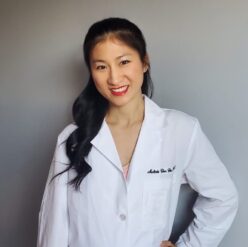Even before starting PA school, I had a strong interest in surgery. I would “follow” and subscribe to accounts on websites such as Youtube, Instagram and Facebook that showed content of surgeries. I also would actively seek out television shows that covered before, during, and after surgeries. To get my healthcare hours, I had searched on Linkedin to find a surgical PA, and had written to her to ask if I could shadow her, as well as observe procedures in the OR. I was excited that York PA school offered a rotation in surgery, and I made sure to let our clinical coordinator know that I wanted to be placed in a hospital that would offer me the best exposure to this specialty. This led me to my surgical rotation at QHC. It was initially meant to be my 5th rotation. However with COVID, it got pushed all the way to being my last rotation. I was nervous about the hours, and about being burnt out when reaching my last rotation. Also since this rotation was one I was looking forward to from the start, I was afraid that it would not meet my expectations. After completing the rotation, I realized that my fears were unfounded, and confirmed that I really did enjoy the surgical PA position.
I originally thought that the rotation only consisted of assisting in surgeries. However, only my first day of orientation, my preceptor already told us that seeing the surgeries was the least of his concerns, and he cared more for the students to see surgical consults, as well as work in the surgical clinics. Eventually I was able to appreciate why he said what he said. It was helpful to see the patients come in with a complaint in the ED, and to learn what is considered a surgical emergency, versus what could be dealt with in outpatient. In the clinics, it was good to see patients coming in to see if they needed to have surgery performed, as well as those returning to clinic after their surgery was completed. I would see the difference between good healing scars versus bad healing scars. From that, I also learned how to care for the wound, or what may need additional surgical intervention. This rotation gave me a holistic understanding of what surgical cases look like, what a surgical department does, as well as how PAs play an integral part in it.
During the rotation, I especially enjoyed those cases where I met patients when they first came in, participated in their surgeries, followed along with their recovery on the floor, and finally was able to see them get discharged from the hospital. One such patient was a man in his late 60s, who was diagnosed with colon cancer on his right side, with possible liver metastases. His surgery was being performed since the colon cancer was close to causing an obstruction. I was able to scrub-in for his right hemicolectomy with primary anastomosis, and liver biopsy. It was the first large open surgery I had the opportunity to participate in. When the patient was placed on the floor for recovery, he was encouraged to practice early ambulation. I was amazed to see how he went from being in such severe pain and needing constant encouragement to walk enough steps to leave his room; to him having minimal pain and voluntarily walking up and down the hallways within days. I was extremely happy for and proud of him. There was a point during his recovery, however, when he was being advanced from NPO to clears, and he started having coffee-ground emesis. This caused a setback in his recovery, where he had to have an NG tube replaced, and restart his NPO/diet regimen. I found this part difficult, where it was unknown how the patient’s recovery was going, and when he would be returning home.
I hope that my preceptor and the staff noticed the way I worked differently from the other students. I went in everyday enthusiastic to learn, and wanting to participate in patient care. When some students would pout about going on small surgical consults, I would openly accept the opportunity to see the patients. For the 24 hour call days, I accepted it as a greater opportunity to learn, which I think made the time go by faster. I felt like I also had great compassion when caring for patients. In surgeries, I made sure to understand why some steps/procedures would be performed over another, and was not afraid to ask. One resident had commented during a surgery that I had good “intuition” when I was handing different instruments. It felt good to be seen and praised for how I performed naturally as a student. When I was taught to do something another way, I was also good at accepting criticism and not letting it get to my head.


